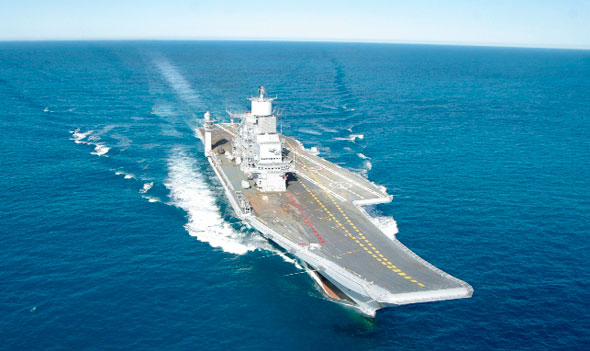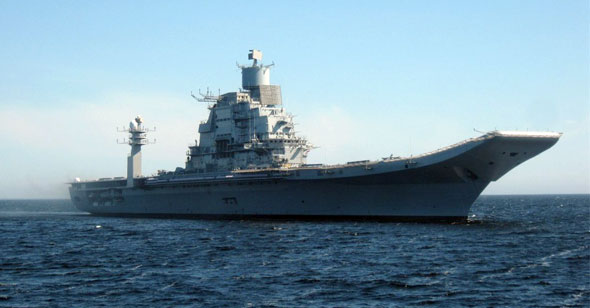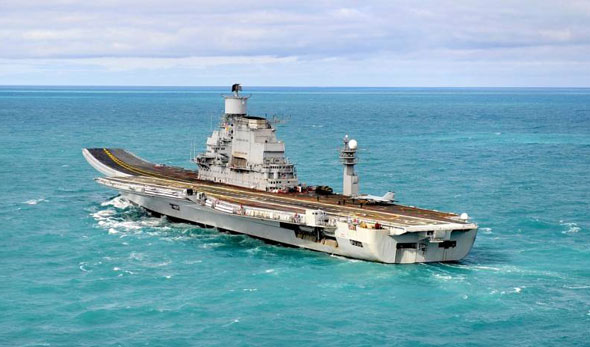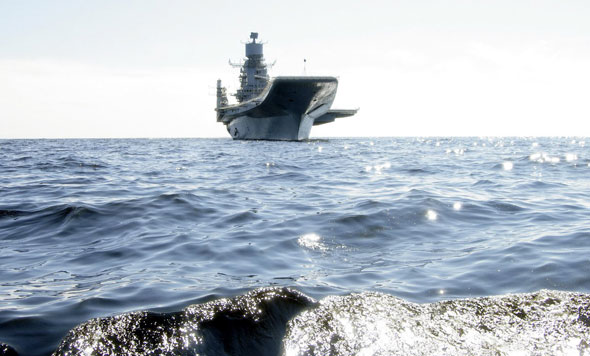With the United States delivering an increasing share of India’s arms imports, New Delhi must work with it to retain control of our regional waters, says Ajai Shukla.

Last week, a navy delegation led by senior Indian admirals visited the United States on a three-day mission that could eventually bind together the two navies for decades to come.
A newly-formed ‘Joint Working Group on Aircraft Carrier Cooperation’ held its inaugural meeting in Washington after President Barack Obama and Prime Minister Narendra Modi agreed to cooperate in this field during the former’s Republic Day visit to India earlier this year.
The JWG discussed how the US Navy — the world’s most experienced and technologically advanced aircraft carrier power — could assist India in building its own fleet of aircraft carriers.
With India looking to build a ‘blue water navy’, i.e. one that can project power across thousands of miles of Indian Ocean, the first indigenous aircraft carrier, INS Vikrant, is already at an advanced stage of construction.
Indian naval planners have long argued the need to have three aircraft carriers in service.
Each CBG, which includes a aircraft carrier, escort vessels (multi-role destroyers and frigates), anti-submarine corvettes, missile boats, logistics support vessels and submarines, is designed to engage in intense combat even without support from fighters operating from shore-based airfields.
The three-carrier dream remains elusive, even with two carriers in operational service today — INS Viraat and INS Vikramaditya — and a third, the INS Vikrant, likely to be completed in Cochin Shipyard Ltd by 2018.
INS Viraat, launched in 1953, is already the world’s oldest serving aircraft carrier and will retire when the Vikrant enters service.

India’s third aircraft carrier, therefore, would only be the Vikrant’s successor, whenever that is built.
Currently on the drawing board and referred to as INS Vishal (a name the navy has not confirmed) this could be the vessel that sees Indo-US high-tech naval cooperation bearing fruit.
Why does India need the US Navy’s help to build the Vishal, even after designing and building INS Vikrant in CSL?
Because, India has only operated small aircraft carriers that displace less than 45,000 tonnes.
The size of a carrier determines how many aircraft it embarks, the ballpark calculation being one aircraft for every 1,000 tonnes.
The 45,000-tonne Vikramaditya embarks 36 aircraft — thirty MiG-29K fighters and six Kamov helicopters. Yet this is not enough.
Ideally, a CBG would like to field at least 50-55 aircraft when operating far from shore-based air support. That calls for at least a 65,000-tonne carrier, something that Indian shipyards have never built.
As important as numbers is the type of aircraft a carrier embarks.

A crucial element of air battle is ‘airborne early warning’, delivered by AEW aircraft — radar-equipped, airborne command posts that scan airspace for enemy aircraft, and direct friendly fighters towards developing threats.
For this job, US Navy aircraft carriers embark the E-2D Hawkeye, a large, twin turbo-prop aircraft that could never get airborne from small carriers like the Vikramaditya or Vikrant.
For this, the US Navy has long operated 100,000-tonne ‘supercarriers’, which launch aircraft with steam catapults — a steam-driven piston that hooks onto the belly of an aircraft and accelerates it to take-off speed in just 2-3 seconds.
The newest American supercarriers, starting with USS Gerald R Ford, which will join the fleet next year, feature an ‘electromagnetic aircraft launch system’ that replace the steam catapult with an electromagnetic system that accelerates aircraft precisely to take-off speed.
The EMALS is smaller, lighter, quicker, and more powerful, and allows the take-off speed to be carefully calibrated for different types of aircraft, reducing stress and wear on their airframes.
The electric power requirements of an EMALS system are too large for conventional generators to deliver; so nuclear propulsion is essential for a carrier fitted with EMALS.
This sums up the Indian Navy’s dilemma for its third aircraft carrier.
It must choose between what it already has — a small, conventionally powered vessel that embarks 30-35 combat aircraft that can be launched only slowly; or, alternatively, a large, nuclear-propelled vessel with EMALS that embarks 50-55 aircraft of varying types including force multipliers like AEW aircraft.
The benefits of this are attractive, since this greatly enhances the power that a CBG can project.
Even so, some strategists believe India would be unwise in investing so much money, capability and symbolism into a single vessel that might be sunk in war.
Opponents of the ‘big carrier school’ argue for greater numbers of smaller vessels like destroyers and frigates, covered by land-based aircraft (including those operating from archipelagic bases like the Andaman & Nicobar Islands) with their ranges extended by air-to-air refuelling.
It will be interesting to see in which direction the Indian Navy goes — whether it chooses a conservative, tactical approach, like the army and the air force, or a bolder doctrine based on sea control and extended reach, of the kind that the US Navy imbibed from strategist Alfred Thayer Mahan.
Henry L Stimson, US Secretary of War all through World War II, memorably described “the peculiar psychology of the [US] Navy Department, which frequently seemed to retire from the realm of logic into a dim religious world in which Neptune was God, Mahan his prophet and the United States Navy the only true church.”
Regardless of how doctrine evolves in the Indian Navy, their American counterparts already regard them as inevitable long-term allies.
Last week, the Indian delegation was taken to the Virginia shipyard where the USS Gerald Ford is being completed, and introduced to EMALS.
With the Defence Technology and Trade Initiative touted as the vehicle for easing US restrictions on technology, Defence Secretary Ashton Carter sees US assistance in aircraft carrier building as the lynchpin, and the two navies as torchbearers, of a close defence relationship.

Strategist Ashley Tellis has argued that Washington might well assist India with developing a nuclear reactor for powering INS Vishal and future Indian aircraft carriers.
But for that, a top-level request would be essential (i.e. PM-to-President) along with firmer assurances of strategic alignment.
In the US system, every grant of assistance must be sponsored by the military service it relates to; and the US Navy will enthusiastically support the provision of cutting-edge technology to the Indian Navy if it believes that would bring it clear operational benefits.
Despite New Delhi’s ambivalence on strategic partnership with America, US vendors are delivering an increasing share of India’s arms imports, inexorably eating into Russia’s share.

India has already spent close to $10 billion in outright US purchases; most of them government-to-government, while co-developing platforms like aircraft carriers have not gotten off the ground.
Last week, America’s ambassador to India, Richard Verma, told a Delhi audience “I see no reason why the United States and India cannot build fighter aircraft together, right here in India.”
While that may be a distant dream, New Delhi must work with the world’s premier aircraft carrier power to retain crucial control over our regional waters.





